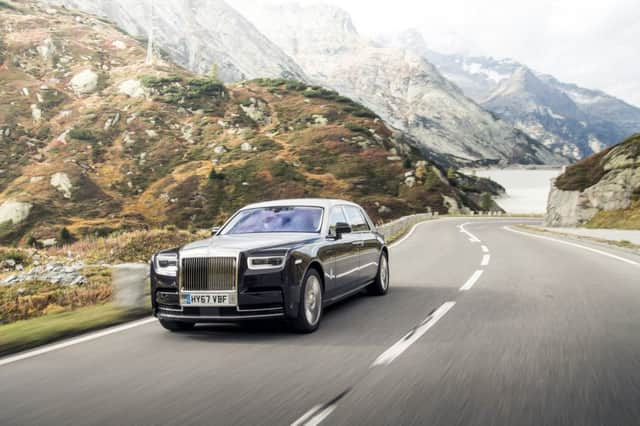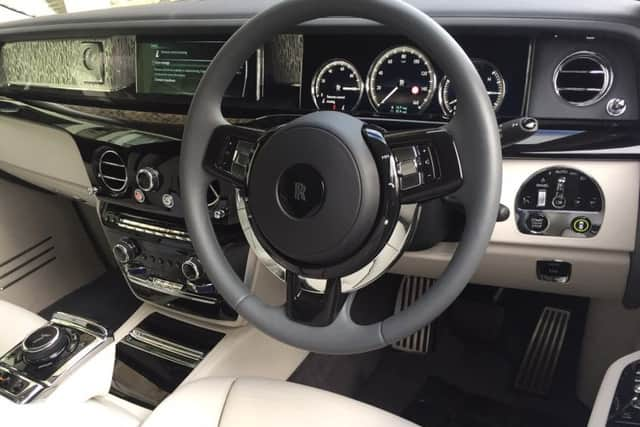Review: Rolls-Royce Phantom


Take a good look, because you may not see another for some time. It is 300kg lighter, with much of the saved weight invested in soundproofing in the roof and as foam inside the massive, bespoke, Continental run-flat tyres.
Phantom is the model for superior occasions and their people, heads of state, royalty, possibly some people who aren’t very nice. Ideally, you are a passenger but your correspondent had to take the wheel and rely on others to report on life in the rear salon. Apparently it was swell.
Advertisement
Hide AdAdvertisement
Hide AdJust seeing one is an event. A young lad was phone-filming it while his pal was actually clapping. That’s a first. Others, toddlers, teens, old, in-betweeners, were enthralled by the opulent interior, the thickness of the floor rugs, the twinkling lights in the roof lining, the doors which closed, silently, by pressing a button.


It came as a shock that to get out they had to open the doors using muscle power – and they do take quite an effort in the back. (Powered opening would be risky.) They are rear-hinged which means leaning forward and pushing at the far end of the door – an ergonomic flaw unless you have a chauffeur or concierge at hand. The system makes it easier to enter the car, but you run the risk of showing your knickers when you leave.
A Phantom glitters. There’s chrome for everything from the jacket hooks to the strap hanger swivels to the push-pull ventilation knobs to the pommel on the umbrella carried in each rear door. Shiny strips edge the bonnet on its way from the screen to the epic radiator facade and a winged mascot – gold on the Phantom. Her famous figure adorns the start-up panel and the retractable BMW-inspired iDrive “command” controls, front and back. This works fine, as does the information screen, but there are still many buttons and switches and such stuff.
Each Phantom is bespoke, not off the peg, ready to wear. This demonstration Phantom was painted gunmetal – a dull sheen – which gave the bulky car a military bearing. One would be pushed to call it beautiful. Inside it is: there was ivory leather and contemporary piano black panels. The left flank of the fascia was a work of modern art holding the clock, in a curve, set behind a clear panel.
These are examples of what an owner may request, things to elevate the journey for the two or three rear travellers. Such as: powered drop-down solid trays on the seat backs. There is a bottle cooler and glasses, powered sliding window blackouts. Face-sized vanity mirrors swing down from the roof. Phantastic stuff for the person or company who can afford what they think is the best car in the world. Oddly, only one USB port was evident – and fiddly to use too.
Just about everything is honed to a silent smoothness. The only indication that the engine has started is a dial showing the power reserve has reached 100 per cent. The car moves off with an astonishing serenity, as if it is responding to thought rather than an accelerator pedal and cogs and mechanical linkages to the wheels. The power meter needle acts like a rev counter in reverse. As the speed rises the needle spins back, so that at maximum power it registers zero.
The steering feels too light and lacking feel, a bit vague and slow until you get its measure. Positioning on the road it is easier than expected. Just aim the bonnet mascot at the nearside kerb. Exterior cameras help with tricky parking but over-shoulder visibility is abysmally poor, blocked by the vast rear and central roof pillars which give passengers privacy.
Once on the move the car is never quite silent. On good roads it gets very near it, emitting little more than a sigh. Wind noise was never evident, nor were the gear changes. Selection is by a lever on the steering column, with a detent to avoid knocking it out of gear.
Advertisement
Hide AdAdvertisement
Hide AdThere is some hum from the tyres – but that’s not surprising because they are huge. Certain road surfaces can be felt and there is a pop from bad ruts and drain covers. Traffic calming humps create a louder thump than expected and rain patter on the screen intrudes noisily on the serenity.
Mostly, progress is effortlessly subliminal so that very soon you’ll be threatening several international speed limits. You can set a tuneful chime to signal these risks. Outside, the 22-inch alloy wheels – forged for strength – spin round the fixed hubs so that the RR monogram is always upright. Appearances matter.
As for the price, who knows? “Rolls-Royce doesn’t publicly communicate pricing information,” said its PR agency. If you have to ask and all that.
Verdict: I’m still thinking.